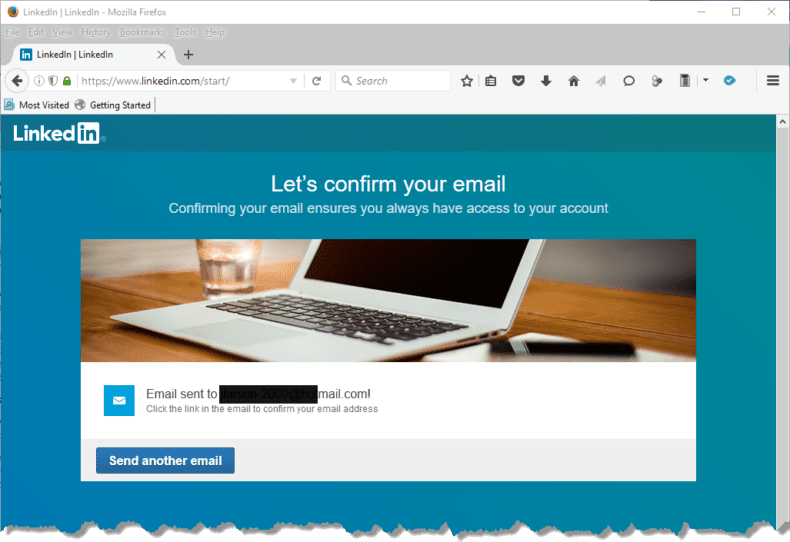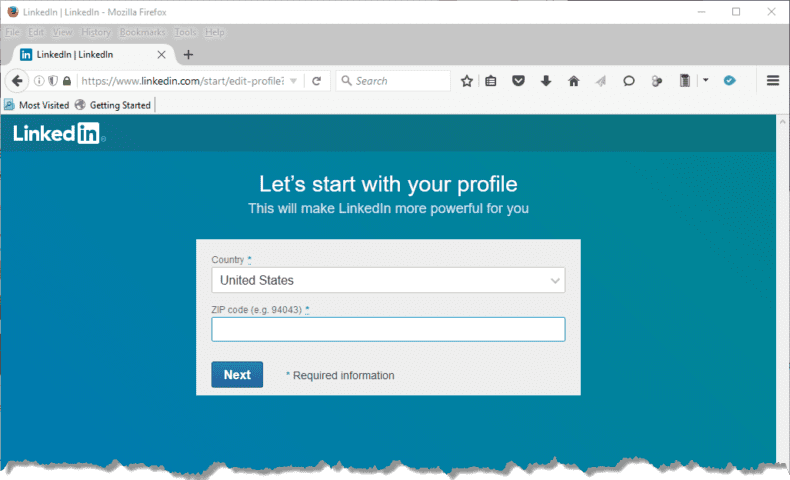
LinkedIn is the cornerstone to B2B networking. You use it to connect to your existing professional network as well as expand your network into secondary and tertiary connections through those you already know. It doesn’t have all the features other social sites have, but it can be really effective in professional horizons.
Step 1: Go to LinkedIn.com

Go to the LinkedIn sign up page.
Enter your full name, phone number, and a password.
Click Join LinkedIn.
Note: You must use your true name when creating a profile. Company names and pseudonyms are not allowed, as explained in their User Agreement.
Learn more if you get a message that reads your email address is already registered.
Step 2: Confirm Your Account

Confirm your account through your email address. Once you’ve done this, sign in and get started.
Step 3: Add Your Details

Once you’ve verified your email, LinkedIn will present you with a series of profile screens. Complete each step as prompted.

Pay attention to the “interest” screen. Each choice will present a different UX. Choose the one that most represents your decision to use LinkedIn.
Step 4: Completing Your Profile

The final step is completing your online profile and this step is critical to your success. The following 10 sections are the areas that will make or break your marketing. On average, optimized profiles garnered on average five times as views as incomplete profiles.
Click on the “Profile” button and complete each section.
Add an image. The picture should be of your face – not your dog. Chose a simple headshot where you are looking straight ahead and do not use a selfie.
I recommend you not skim and have a professional picture taken and this will be how everyone “sees” you. It doesn’t have to be boring or artificial, you don’t have to wear business attire. but the image should look professional and pleasant. It’s okay to smile. You are going for “dependable” and “trustworthy.” Avoid “sexy” or “quirky.”
The old adage is true. People remember faces more than names. This is also why one needs to see your face and not some other part of you. For example, a chef should still use a headshot and not a photo of her/himself in the kitchen. Pictures that attest to a specific skill or talent can be uploaded elsewhere on your profile, along with training videos and presentation materials.
Add a Headline. You have 120 characters at the top of your profile to describe to the world what you do. Many people just put their official job title. Which is one way to go… or you can really use the system to your advantage here. Choose descriptive and compelling keywords that a) make you as marketable as possible, and b) help you get found by the right people. Remember, LinkedIn is a search engine.
Examples of effective headlines are “Recruiter, HR, Talent Management Expert” or “Brand Marketing, PR, Communications Professional.” Comes in handy especially if you are currently looking for work.
Add a Summary. This is a chance to write a more in-depth paragraph to give people an idea of where you stand now in your career, what your strengths are, where you want to go and what you have to offer. Although it’s a summary, it can take some time to write a good one, so don’t be afraid to edit it ruthlessly until it reads well.
Think of this as your elevator pitch. These are the first sentences people read, and you have a very short time to grab the reader’s attention and make them want to read more. You can include high-resolution photos, an infographic of your experience, or a video of a talk you gave. It is well worth it to put in the effort to write a unique and captivating summary section.
There are several ways to write a good Summary. It could be a copy/paste of your resume’s summary section. Or it could read more like your bio. You could take a core competencies approach and list the three or four key skills you bring to the table. You could take an accomplishments approach and list the three or four big results you have achieved on behalf of your past employers or clients.
Or you could get quite creative and pair an interesting story with a section called “what you won’t find on my resume.” How far you can go in terms of creativity depends to some extent on your industry, as some are more traditional than others.
In any event, at the end of this section, the reader must have a strong idea of who you are and how you help people. End with a Call to Action (CTA) — for example, “Please reach out to discuss opportunities in X, Y, and Z.”
Edit your qualifications. Add your current and past employment as well as your education. Be sure to include descriptions of your past jobs and degrees earned – this way, people will be able to more clearly see your experiences and know what to contact you for. LinkedIn can also tailor job suggestions to send you if you’ve provided adequate details.
There are two basic ways to handle this section:
Adapt it from your resume; you can copy/paste the relevant job descriptions and accomplishments for each position.
If you are uncomfortable listing too much information under specific employers, you can simply add the name of employer, your position, dates, keep the rest blank, and include in the Summary a more general “skills-based” experience piece.
Be sure to include your current position and at least two other positions.
Add Specialties. This is located directly below. It acts as an extension of the Summary section but in short form. You can list specific skills and areas of expertise.
Choose wisely – other members of LinkedIn can endorse you for these specialties, so avoid choosing something people don’t have any clue you’re capable of doing!
Add Websites. Link in your company’s website, your own personal site, your blog, and/or your Twitter account. This will allow visitors to your page to see different aspects of your professional self.
Be cautious of linking in your Facebook page if you have questionable photos of yourself, or to your Twitter account, depending on the language of your tweets.
Get Recommendations. Recommendations can be one of the most valuable tools in building up your credibility in the job marketplace. You’ll have to be proactive and ask for recommendations from anyone: bosses, colleagues, mentors and mentees, happy clients, or anyone who has collaborated with you and benefited from your skills or advice. A well-crafted recommendation that is genuinely glowing from a peer is better than a few generic sentences from a high-level managing director.
It’s best is to have a strategy like asking people to address a particular skills or highlight certain experiences with as much detail as possible. Help out your recommenders by giving them this detail. For example, if you want them to highlight leadership skills, remind them of two or three instances when you skillfully led a project. Finally, ensure that the sum total of your recommendations covers all your skills and experiences, and that the content in them backs up (or least does not contradict) what you wrote about yourself.
Once you initiate this marketing method, remember to continually follow up and and always thank your recommenders and offer to recommend them too. In fact, go one step further and send along a draft of a potential recommendation.
Think SEO. Use keywords everywhere, especially in the Summary and Experience sections, for search engine optimization (SEO) purposes. When recruiters use LinkedIn, they use certain industry–specific keywords. These are the terms that will help you show up in their search results within LinkedIn.
Ways to figure out your keywords:
What words and phrases might people in your target market use to search for someone with your background, experience, and service offering? Go to the Careers page of some potential employers you are interested in, and pick common keywords around that job or industry.
Add Applications. These are not necessary, but having them can make your profile more complete.
For example, you can add Blog Link for a stream of your blog or other website updates. You can add the Reading List application by Amazon to let everyone know what books you’re reading and which ones you recommend. With other applications, you can share files or presentations.
Join Groups and Associations.
Groups are a way to build relationships and network with people who are doing similar work or have similar interests as you. You have about 1.3 million groups on LinkedIn to choose from.
Join as many relevant groups as you can and contribute to the conversation. As a start, join the alumni groups for where you went to school and any industry association groups pertinent to your line of work. When you join the discussion, try to lend your expertise to benefit the conversation and to show your interest and your value.
Final Thoughts
Add Connections. You can have LinkedIn search through your email address book to find people you know. You can also search by a person’s name, job title or company.
There are two school of thought when it comes to connections:
Strategic Networking
The focus on quality – not quantity. Strategic networkers typically have fewer than 500 people in their network and keep in touch with about 100 to 150 people in their network. They have deep connections with a small number of people.
Open Networking
Open networkers are often referred to as LIONs (LinkedIn Open Networkers). The strategy is to gain as many connections as possible. Open networkers typically have thousands of connections because their business is a numbers game. The more people in your network, the easier it is to find someone to fill an open position or outreach customers for a sale. As an open networker, you have a limited connection with a lot of people.
Complete Your Profile. According to LinkedIn, your profile will appear 40 times more in search results if it is “complete.” In other words, you will be open to 40 times more opportunities if you do this. So please do.
Here is LinkedIn’s definition of a 100% Complete Profile:
- Your industry and location
- An up-to-date current position (with a description)
- Two past positions
- Your education
- Your skills (minimum of 3)
- A profile photo
- At least 50 connections
LinkedIn Profile Example
